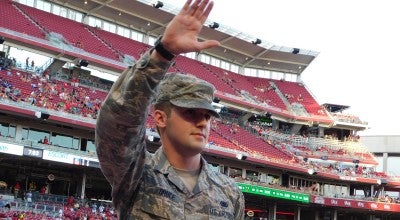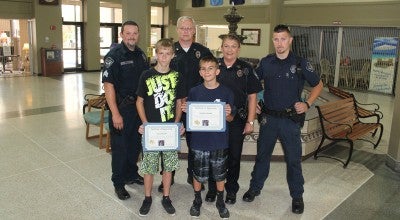Taking flight
Published 2:48 pm Tuesday, May 17, 2011
High-pitched screams and squawks could be heard from the peregrine falcons, circling above the nest box on the Ironton-Russell Bridge in a cloudy, misty sky Monday morning.
Protective of their nest and two chicks, the two falcons seemed alarmed by the Ohio Department of Natural Resources workers temporarily taking the chicks down from the bridge. They had no way of knowing their chicks would be promptly checked out, banded, named and returned.
“We put bands on their legs,” said Jennifer Norris, ODNR wildlife research biologist. “It’s like a social security number, giving them a number no other bird has.”
Lindsey Linkhart, ODNR wildlife communications specialist, said the reason for keeping such a close eye on the birds is because of their small population.
because of their small population.
“In Ohio they were listed as endangered, but they were removed from the list in 2008,” Linkhart said. However, they are currently listed as threatened in the state of Ohio.
The banding is harmless to the falcons and allows them to be tracked to help learn more about them.
The two female chicks, between two and a half and three weeks old, were named at the event — Hopewell and Votto. When the eggs were first detected there were four. Only three of them hatched, and one disappeared before ODNR was able to help move the nest.
More than three dozen people showed up at the park pavilion on the Kentucky side of the bridge to see the chicks, 20 of them students from Denise Fraley’s eighth-grade Rock Hill Language Arts class. This is the fifth year Fraley has brought students to witness the event.
Katie VanMeter, Rock Hill eighth grader, said she thought the chicks were cute and remembered some things she had learned about the falcons this school year.
“I learned about where they used them in the war,” Katie said. She added that the falcons were used to kill the messenger pigeons, to hamper communication during conflict.
Jose Akers, 8th grader, remembered what the falcons eat.
“Birds, little mammals, fish — just about anything they can catch,” Jose said.
To attend this event, Fraley’s class is required to do extra work on their own time and 20 of those students were chosen from a drawing and given the chance to go. Some of the extra projects the students did were research papers, answering questions posted on Fraley’s blog, watching a movie about the birds, keeping track of falcons online and other assignments.
“I think it’s really worth it,” Jose said about the extra work. “It’s fun and interesting too.” While Jose said he wasn’t a fan of birds before this class, now every time he goes across the Ironton-Russell Bridge, he looks for the falcons.
“They absolutely love it,” Fraley said. “They get a lot of technological experience, a lot of informative reading.”
Greg Jackson took his daughter, Leela, 7, with him to see the chicks.
“I think they’re pretty cool,” Leela said. “I have learned a lot of other things about birds.”
Jackson said his older daughter, Kate, started attending the banding when she was 8 and is now 15. Charles and Linda Reneau, grandparents of Kate and Leela, were there too, and have been going since 2003. Charles Reneau said he is especially interested in birds, like the peregrine falcon, that are uncommon.
“They’re a marvelous hunter,” Charles Reneau said.
Norris said this is a nesting record this year, with 29 nestings in the state of Ohio and only 20 last year.
“We are pretty privileged that we have access to one,” Fraley said.
The falcons keep their chicks in the nest until it’s time for them to leave, and if they don’t go on their own, the falcons kick them out of the nest, Norris said.
Surviving the first year is crucial, as they’re just learning to hunt for themselves and survive on their own. Some falcons have lived as long as 18 years, but that is considered very rare.





